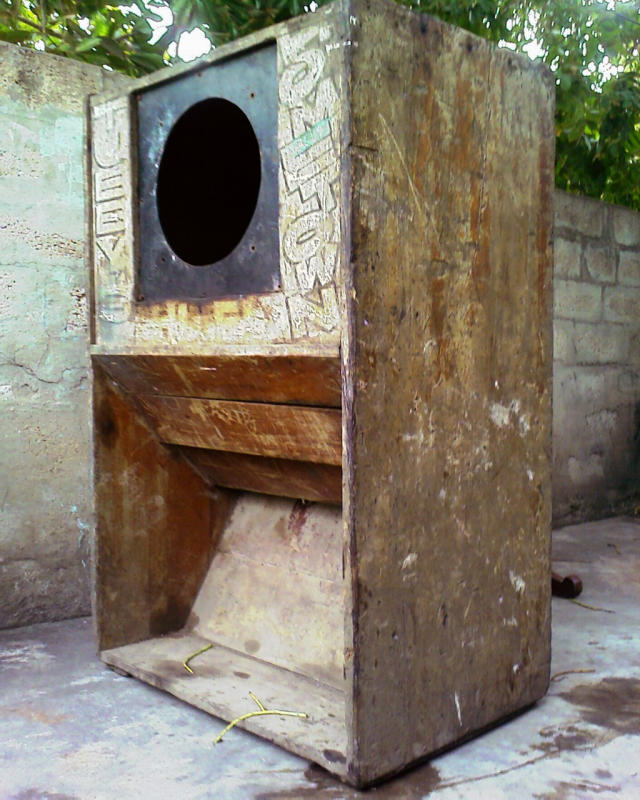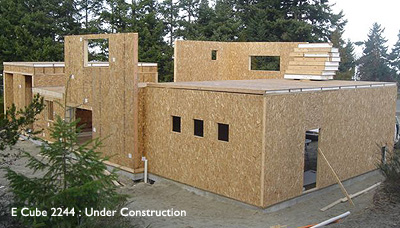Schwarz
View current page
...more recent posts
To get along in life, everybody needs pretty much the same thing — but not exactly the same thing.
That's the problem given historical shape by "Modernism: Designing a New World, 1914-1939," the vast, thought-provoking show opening Saturday at the Corcoran. It touches on virtually every art form, from drawing and painting to cinema and dance. But because the show originated at the Victoria and Albert Museum, one of the world's great repositories of design and decorative arts, the more populist media — architecture, design, graphic art — resonate loudest.

via the fmu blog
...............................

e-cube house via justin
if you are familar with the maysle brothers documentary Salesman, then you may remember the location ali-baba avenue in opa-laca florida. its just a little north and west of miami. i know it personally because i worked for my uncle who had a fishing tackle manufacturing company there summer '73.
opa-laka is in the nyt today, they're boarding-up city hall :
Where the scrub palmetto once grew wild, Opa-locka has languished as a violent, drug-addled void on a cartoon stage set, one fantasyland too many in an oversubscribed state. Beneath a film of dust, a suggestion box at City Hall holds a single blue slip that says, “The best suggestion would be more police.”via vz
For rehabilitation, the city has turned time and again to promoting the legacy of its architecture, a peculiar homage to Moorish antiquity that includes 20 buildings on the National Register of Historic Places. Down streets called Sesame, Aladdin and Caliph, archways and turrets are adorned with brilliant mosaics and muted flowers in bas-relief.
But now even the fantasy’s veneer is crumbling. Pronouncing City Hall’s roof unsound, the walls moldy and the rats intolerable, the City Commission voted last month to move to rental space in a new four-story office building most vividly described as rectangular.
Many years ago Meyer Schapiro argued that there was a radical difference between art’s spiritual value and its commercial value. He warned against the nihilistic effect of collapsing their difference. I will argue that today, in the public mind, and perhaps in the unconscious of many artists, there is no difference. The commercial value of art has usurped its spiritual value [i would say use value], indeed, seems to determine it. Art’s esthetic, cognitive, emotional and moral value -- its value for the dialectical varieties of critical consciousness -- has been subsumed by the value of money.
Art has never been independent of money, but now it has become a dependency of money. Consciousness of money is all-pervasive. It informs art -- virtually everything in capitalist society -- the way Absolute Spirit once did, as Hegel thought. Money has always invested in art, as though admiring, even worshipping, what it respected as its superior -- the true treasure of civilization -- but today money’s hyper-investment in art, implicitly an attempt to overwhelm it, to force it to surrender its supposedly higher values [thus neutralizing all art and artists functioning in service to the system], strongly suggests that money regards itself as superior to art.
ohio or pennsylvania house construction photo series
the enbankment jc style
floyd in kearny
bronzing the radiator
the rockefeller apartments - the jewel of 55th street
caulking ny - its a tschumi thing
from the advertecture desk :
Looks like Apple is continuing to build awareness for the Apple iPhone. On Monday March 12th, workers at the 5th Avenue Apple Store in New York City posted a large iPhone ad on one full side of the glass structure.via curbed
ok oilfield
One day in the winter of 2003, John Hon opened an e-mail to Single Speed Design the architecture firm he runs with his wife Jinhee Park, in Cambridge, Massachusetts. It was from a structural engineer named Paul Pedini, who said that he had seen a Single Speed project and liked it so much that he wanted to hire the firm for an unusual project. He explained that he worked at a contracting company that had spent decades on the Big Dig, the huge project to replace Boston’s elevated Centra Artery with a tunnel, and that he had come up with the idea of using steel and concrete salvaged from the project to put up a building. “It would be sort of like Junkyard Wars meets Habitat for Humanity,” he wrote.
Hong wondered how to respond. “You get a lot of weird e-mails if you put your sign in front of a construction site,” he said. But he and Park went to meet Pedini in a junk yard a few miles north of Boston where the company was storing highway sections. “When I saw all this stuff, I realized he was serious,” Hong said.
clark kent supply co
fake cigarette burn
baudrillard and form :
Consider the shades of Lacan in the discussion of the real. One of the three registers (along with the imaginary and the symbolic), the real is barred from entry into the ego at the mirror stage, the moment of identification that is constituted on an image, that constitutes the imaginary basis of objectivity - we (as "I") are constituted by our (as "my") images in another. The subject takes an image for self, and the "I" condenses into a form, a fictional wholeness the ego never attains. The illusion of form is the specular "I" that the subject may never match - note that this is prior to the subject's linguistic entry into the world, prior to the association of the subject with the language that will become the horizon of its possibilities.
Baudrillard is making a point about the power of simulation vs. representation - "the latter," writes Baudrillard, "starts from the principle that the sign and the real are equivalent" (11). So the specular "I" molds itself by power of such an assumption. The entry into language transfers the power of the specular "I" into language - the sign becomes the more scientifically accessible relationship between signifier and signified, assuming the force of the real. But we know that the image cannot represent the full force of the real - if the real is irreducible, how is it reduced to an image? And if it can't be represented, how do we come to know it? The viewer seeks to be united with the view, but there is always that barrier to true integration with the real. So some of the power of origin is granted to the sign, in order to make the origin's power known to us. Baudrillard then continues:
Conversely, simulation starts from the utopia of this principle of equivalence, from the radical negation of the sign as value, from the sign as reversion and death sentence of every reference. Whereas representation tries to absorb simulation by interpreting it as false representation, simulation envelops the whole edifice of representation as itself a simulacrum." (11)
From Kenneth Frampton's Studies In Tectonic Culture, on Meis, building and form :
As he put it in an interview with Christian Norberg-Schultz in 1958 "We do not like the word 'Design.' It means everything and nothing. Many believe they can do everything from design a comb to planning a railway station - the result is nothing is good. We are only interested in building. We would rather that architects use the word 'building' and the best results would belong to the 'art of building.' "
[...]
We refuse to recognise the problems of form, but only problems of building.
Form is not the aim of our work, but only the result.
Form by itself, does not exist. Form as an aim is formalism; and that we reject.
Essentially our task is to free the practice of building from the control of the aesthetic speculators and restore it to what it should be: building.
desperately bad news for internet radio
As you can imagine, designing $400 huts for a Caribbean island doesn't pay much. So why make even less by giving your ideas away? Aside from the good karma, it might just get you a slew of streamlining tools -- and more work, even some that pays.
Nonprofit Architecture for Humanity is convincing the building industry to share -- be it blueprints, engineering specs or construction tips -- through its latest project, the Open Architecture Network.
The open source site, which goes into beta today, is a one-stop spot for anyone involved with innovative and sustainable buildings (think: architects, engineers, community leaders, nonprofit groups, government agencies and technology companies). Consider it the match.com for architects wanting to meet community leaders and nonprofits with open dance cards, when it comes to backers and builders for a project.
Loaded with projects and concepts, the site is built so people can upload info, comment on and, in some cases, download building or project specs. Housed on two servers totaling six terabytes, the site doesn't limit file size -- a major coup for architects who typically work on megabyte-heavy CAD files.
The Fab Tree Hab is an all-green concept home that will grow from "a few seedlings into a two-storey, water-recycling, energy-efficient abode," according to researchers, largely from the Massachusetts Institute of Technology. They expect it will take a minimum of five years for one of their homes to grow, depending on the surrounding climate.
here is what artnet (the leading online art world resource) has to say about the recent death of jean baudrillard. thats right, nothing.
*see artnet status updated in comments
A barrel-shaped restaurant that first opened in 1937 on Route 66 in Amarillo, Tex., may have reached the end of the road.
Beloved for its hamburgers and chicken-fried steak sandwiches, the Beef Burger Barrel closed on Feb. 3.
aversion to life - dallas tx
via vz
